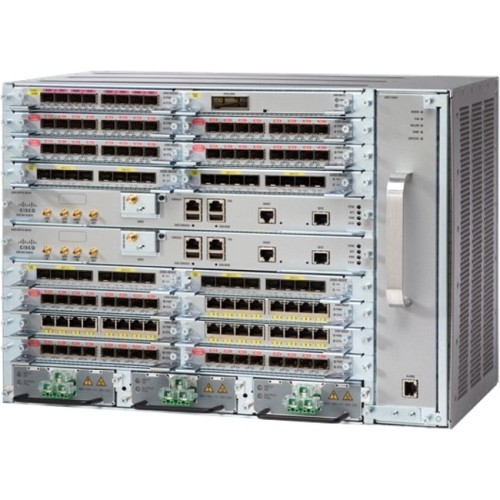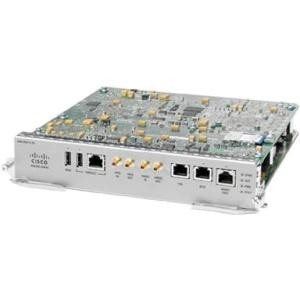Cisco ASR 907 Router Chassis - 18.0 - 7U - Rack-mountable - 90 Day ASR-907++
ASR-907++ | Cisco®
Part Number: ASR-907++
Condition: New
In Stock:
Manufacturer Drop Ship
Real time availability 
Product Specifications
Cisco ASR 907 Router Chassis - 18.0 - 7U - Rack-mountable - 90 Day ASR-907++
ASR 907 SERIES ROUTER CHASSIS (TAA)
Manufacturer Part Number: ASR-907++
Factory Direct Only - Cisco ASR 907 Series Router Chassis
MANUFACTURER NAME: Cisco
MANUFACTURER PART NUMBER: ASR-907++
UPC EAN CODE:
LANGUAGE: EN
MARKET:US
| General Information: | |
Major Applications Broadband Aggregation The modular Cisco ASR 900 Series router supports broadband aggregation for delivering "any-play" services (voice, video, data, and mobility). Designed to support thousands of subscribers, the ASR 900 Series includes quality of service (QoS) features that allow the routers to scale to a large number of queues per device. Combined with a highly granular, three-level hierarchical QoS algorithm, a large number of queues can result in a greatly enhanced broadband user experience. This full-featured Layer 2 and Layer 3 router supports a variety of broadband applications, including IPTV and video on demand (VoD), enhancing and extending the Cisco Evolved Programmable Network architecture. Preaggregation for Mobile Applications Deployed as a preaggregation platform for mobile backhaul, the ASR 900 Series router can aggregate cell sites and use Multiprotocol Label Switching (MPLS) as a transport for Radio Access Network (RAN) backhaul traffic. It also provides the timing services required in today's converged access networks by offering integrated support for the Building Integrated Timing Supply (BITS), 10 MHz, 1 Pulse Per Second (1PPS), and Time Of Day (TOD) interfaces. The router also supports synchronous Ethernet (SyncE) and IEEE-1588, and it can act as the source for network clocking for time-division multiplexing (TDM), Synchronous Digital Hierarchy (SDH), Synchronous Optical Network (SONET), Synchronous Ethernet (SyncE), and Global Positioning System (GPS) interfaces. In addition, the ASR 900 Series router can be deployed in small and rugged environments, due to its shallow depth and qualification for extended temperature ranges. Metro Ethernet Aggregation The ASR 900 Series router is built to meet service provider requirements for Carrier Ethernet aggregation. It is optimized for remote central office and smaller aggregation sites where a full-featured, modular, small-footprint, and fully redundant aggregation platform is needed. This router offers service flexibility and delivers Layer 2, IP, and MPLS transport for advanced L2VPN, L3VPN, and multicast services. Major Differentiators The ASR 900 Series router helps service providers deliver advanced services for residential broadband, mobile, and Metro Ethernet applications. This allows an operator to provide differentiated and cost-effective services to end users. Flexible Deployment Options The ASR 900 Series router is designed with a compact form factor to accommodate deployment in small spaces. Available with a range of mounting options, the router can be deployed in space-constrained locations such as ETSI 300-mm deep cabinets. The side-to-side airflow design allows two Cisco ASR 900 Series routers to be mounted back-to-back in a 600-mm cabinet, while the extended temperature range supported by the router allows it to be deployed in locations with minimum environmental control. Small footprint and extended temperature range support allow service providers to extend the reach of their Carrier Ethernet networks to more challenging and remote locations, yet save money on air conditioning. | |
| Manufacturer | Cisco Systems, Inc |
| Manufacturer Part Number | ASR-907 |
| Manufacturer Website Address | http://www.cisco.com |
| Brand Name | Cisco |
| Product Series | ASR 900 |
| Product Model | ASR 907 |
| Product Name | ASR 907 Router Chassis |
| Product Type | Router Chassis |
| Interfaces/Ports: | |
| Powerline | No |
| Management Port | No |
| I/O Expansions: | |
| Total Number of Expansion Slots | 18.0 |
| Power Description: | |
| PoE (RJ-45) Port | No |
| Redundant Power Supply Supported | Yes |
| Physical Characteristics: | |
| Compatible Rack Unit | 7U |
| Form Factor | Rack-mountable |
| Height | 12.2" |
| Width | 17.4" |
| Depth | 9.2" |
| Weight (Approximate) | 34.90 lb |
| Miscellaneous: | |
| Environmentally Friendly | Yes |
| Warranty: | |
| Warranty | 90 Day |
Questions and Answers
Questions and Answers | Ask CompSource |
Shipping / Returns
Shipping
Ground =
FREE
(Delivery within 2-7 business days)
Two Day Air = $28.00
(Delivery within 2 business days)
Standard One Day = $49.00
(Delivery within next business day)
Priority = $75.00
(Delivery within next business morning)
U.S Mail Priority (AA,AE,AP only) = $38.50
FedEx International Economy (Canada only) = $88.00
This item is currently available direct from the manufacturer. Normal fulfillment is 7-21 business days, but can vary depending on the item. Refurbished items can take longer depending on availability of the product. Once purchased, you will be on a waiting list. Automated tracking may not be updated on our site for either of these scenarios, please contact a representatives for more information regarding a particular product.
Shipping dates are best estimates based on product location and may vary with holidays.
If product requires trucking, additional fees may apply.
* Some destinations are subject to Applicable State/Duty Taxes
Returns
CompSource realizes that every product may have different return guidelines. Please see the policy below regarding this item.
Please Note: Due to Cisco's Policy this product is not available for return or exchange and must be handled with Cisco Direct.
For support on this product, please contact Cisco. 800-553-6387 www.cisco.com
Cisco Company's Information
Click Cisco for all products
Local #: (408)526-4000
Toll Free #: 800-553-6387
Tech Support #: 800-553-2447
Site: www.cisco.com
Product Reviews
Overall Rating | Write a Review
|
|
Best Sellers
More Best Sellers
About Cisco
Cisco's approach to quality can be condensed down to one phrase: "ensuring our customer success". The information contained in this section will help you to gain a better understanding of Cisco's Business Management System, which allows us to accomplish that success. Cisco's Business Management System is made up of two parts; the Quality Management System and the Environmental Management System.
Cisco Fun Facts
Cisco Systems, Inc. is an American multinational technology conglomerate headquartered in San Jose, California, in the center of Silicon Valley, that develops, manufactures and sells networking hardware, telecommunications equipment and other high-technology services and products. Through its numerous acquired subsidiaries, such as OpenDNS, WebEx, Jabber and Jasper, Cisco specializes into specific tech markets, such as Internet of Things (IoT), domain security and energy management.
Cisco is the largest networking company in the world. The stock was added to the Dow Jones Industrial Average on June 8, 2009, and is also included in the S&P 500 Index, the Russell 1000 Index, NASDAQ-100 Index and the Russell 1000 Growth Stock Index.
Cisco Systems was founded in December 1984 by Leonard Bosack and Sandy Lerner, two Stanford University computer scientists, who pioneered the concept of a local area network (LAN) being used to connect geographically disparate computers over a multiprotocol router system. By the time the company went public in 1990, when it was listed on the NASDAQ, Cisco had a market capitalization of $224 million. Cisco was the most valuable company in the world by 2000, with a more than $500 billion market capitalization
Here are some great product categories from Cisco;
Learn more about Routers & Gateways
Switches, routers, and wireless access points
Switches, routers, and wireless access points perform very different functions in a network.
A computer network, or data network, is a digital telecommunications network which allows nodes to share resources. In computer networks, computing devices exchange data with each other using connections (data links) between nodes These data links are established over cable media such as wires or optic cables, or wireless media such as WiFi.Switches
Switches are the foundation of most business networks. A switch acts as a controller, connecting computers, printers, and servers to a network in a building or a campus.
Switches allow devices on your network to communicate with each other, as well as with other networks, creating a network of shared resources. Through information sharing and resource allocation, switches save money and increase productivity.
There are two basic types of switches to choose from as part of your networking basics: managed and unmanaged.
- An unmanaged switch works out of the box but can't be configured. Home-networking equipment typically offers unmanaged switches.
- A managed switch can be configured. You can monitor and adjust a managed switch locally or remotely, giving you greater control over network traffic and access.
Routers
Routers connect multiple networks together. They also connect computers on those networks to the Internet. Routers enable all networked computers to share a single Internet connection, which saves money.
A router acts a dispatcher. It analyzes data being sent across a network, chooses the best route for data to travel, and sends it on its way.
Routers connect your business to the world, protect information from security threats, and can even decide which computers receive priority over others.
Beyond those basic networking functions, routers come with additional features to make networking easier or more secure. Depending on your needs, for example, you can choose a router with a firewall, a virtual private network (VPN), or an Internet Protocol (IP) communications system.
Access points
An access point* allows devices to connect to the wireless network without cables. A wireless network makes it easy to bring new devices online and provides flexible support to mobile workers.
An access point acts like an amplifier for your network. While a router provides the bandwidth, an access point extends that bandwidth so that the network can support many devices, and those devices can access the network from farther away.
But an access point does more than simply extend Wi-Fi. It can also give useful data about the devices on the network, provide proactive security, and serve many other practical purposes.
*Access points support different IEEE standards. Each standard is an amendment that was ratified over time. The standards operate on varying frequencies, deliver different bandwidth, and support different numbers of channels.
Wireless networking
Wireless networking is a method by which homes, telecommunications networks and business installations avoid the costly process of introducing cables into a building, or as a connection between various equipment locations.CompSource will educate and help make this process enjoyable and easy.
Whether you're planning on using your network for basic home tasks or enterprise level security. You can tell our trained sales professionals your needs, and we�ll make custom recommendations to suit your specifications and budget. Our reps have extensive knowledge and love to share. We educate, not sell, CompSource makes sure you buy what you need and not waste money on what you don't. As with every decision we never push, it's up to you when, and if you make a purchase.
CompSource has a great technical staff that can help with a solution for your exact needs.
Chat with us or give our professionals a quick phone call (800)-413-7361.
Good price, availability, shipping charges. stkquoteMore Reviews

























